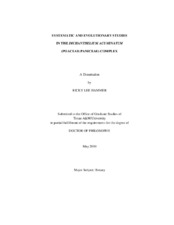| dc.contributor.advisor | Manhart, James | |
| dc.contributor.advisor | Hatch, Stephan | |
| dc.creator | Hammer, Ricky Lee | |
| dc.date.accessioned | 2011-08-08T22:47:49Z | |
| dc.date.accessioned | 2011-08-09T01:33:54Z | |
| dc.date.available | 2011-08-08T22:47:49Z | |
| dc.date.available | 2011-08-09T01:33:54Z | |
| dc.date.created | 2010-05 | |
| dc.date.issued | 2011-08-08 | |
| dc.date.submitted | May 2010 | |
| dc.identifier.uri | https://hdl.handle.net/1969.1/ETD-TAMU-2010-05-7811 | |
| dc.description.abstract | Taxonomic boundaries and systematic relationships in the grass subspecific complex Dichanthelium acuminatum were investigated with both morphological and molecular methods. Circumscription of subspecific taxa comprising the complex has been difficult due to a continuum of morphological character variation among taxa and possibly due to infraspecific and interspecific hybridization. Qualitative and quantitative morphological character data was collected from herbarium specimens and field-collected specimens and analyzed using multivariate statistical techniques. Representative specimens were selected for molecular phylogenetic analysis of DNA sequences from the GBSSI (waxy) nuclear gene. Subspecific boundaries as circumscribed in the most recent taxonomic treatment (10 subspecies) were tested from: 1) a morphological perspective with results of the multivariate statistical analysis to determine if the study specimens formed natural groupings that corresponded to the recent treatment; and, 2) with molecular phylogenetic analysis to estimate the evolutionarily significant lineages present and to determine if such lineages supported the natural groupings revealed from the multivariate morphological analysis. A separate investigation was conducted using a molecular technique to screen for putative hybrid specimens from DNA obtained from field-collected specimens.
Multivariate statistical analysis of the morphological data provided support for four of the 10 taxa tested and additional support for two taxa considered as a single unit. Further research is needed to determine the appropriate status of the remaining six taxa of the ten taxa tested. Molecular phylogenetic analysis provided support for recognizing four evolutionarily significant units and provided parallel support for four of the five taxa recognized from the morphological analysis. The hybridization investigation identified two putative hybrid specimens, which were confirmed as hybrids with GBSSI sequence data and also with multivariate statistical analysis of morphological data to provide provisional evidence for the role of hybridization in producing specimens with intermediate morphological phenotypes. A taxonomic treatment and dichotomous key was produced for the 10 subspecific taxa of the Dichanthelium acuminatum complex. | en |
| dc.format.mimetype | application/pdf | |
| dc.language.iso | en_US | |
| dc.subject | Poaceae | en |
| dc.subject | Dichanthelium acuminatum | en |
| dc.subject | GBSSI | en |
| dc.subject | principle coordinates analysis | en |
| dc.title | Systematic and Evolutionary Studies in the Dichanthelium acuminatum (Poaceae:Paniceae) Complex | en |
| dc.type | Thesis | en |
| thesis.degree.department | Biology | en |
| thesis.degree.discipline | Botany | en |
| thesis.degree.grantor | Texas A&M University | en |
| thesis.degree.name | Doctor of Philosophy | en |
| thesis.degree.level | Doctoral | en |
| dc.contributor.committeeMember | Pepper, Alan | |
| dc.contributor.committeeMember | Wilson, Hugh | |
| dc.type.genre | thesis | en |
| dc.type.material | text | en |


